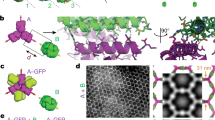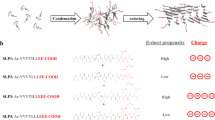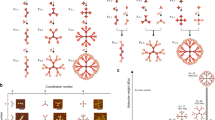Abstract
Fractal topologies, which are statistically self-similar over multiple length scales, are pervasive in nature. The recurrence of patterns in fractal-shaped branched objects, such as trees, lungs and sponges, results in a high surface area to volume ratio, which provides key functional advantages including molecular trapping and exchange. Mimicking these topologies in designed protein-based assemblies could provide access to functional biomaterials. Here we describe a computational design approach for the reversible self-assembly of proteins into tunable supramolecular fractal-like topologies in response to phosphorylation. Guided by atomic-resolution models, we develop fusions of Src homology 2 (SH2) domain or a phosphorylatable SH2-binding peptide, respectively, to two symmetric, homo-oligomeric proteins. Mixing the two designed components resulted in a variety of dendritic, hyperbranched and sponge-like topologies that are phosphorylation-dependent and self-similar over three decades (~10 nm–10 μm) of length scale, in agreement with models from multiscale computational simulations. Designed assemblies perform efficient phosphorylation-dependent capture and release of cargo proteins.
This is a preview of subscription content, access via your institution
Access options
Access Nature and 54 other Nature Portfolio journals
Get Nature+, our best-value online-access subscription
$29.99 / 30 days
cancel any time
Subscribe to this journal
Receive 12 print issues and online access
$259.00 per year
only $21.58 per issue
Buy this article
- Purchase on Springer Link
- Instant access to full article PDF
Prices may be subject to local taxes which are calculated during checkout





Similar content being viewed by others
Data availability
The authors declare that all data supporting the findings of this study are available within the paper and its Supplementary Information files. Raw data used to generate all figures are available via Figshare (https://figshare.com/projects/Stimulus-responsive_Self-Assembly_of_Protein-Based_Fractals_by_Computational_Design/61976), and cryo-ET maps are available in the EMDB (accession codes EMD-20062 and EMD-20063).
Code availability
Scripts and input files used for Rosetta simulations and code used for coarse-grained simulations are available from a GitHub repository (https://github.com/sagark101/Nchem-Fractal-Assembly).
References
Mandelbrot, B. B. The Fractal Geometry of Nature (W. H. Freeman & Company, 1982).
Stanley, H. E. & Meakin, P. Multifractal phenomena in physics and chemistry. Nature 335, 405–409 (1988).
Losa, G. A. Fractals in Biology and Medicine Vol. IV (Birkhäuser, 2005).
Fairbanks, M. S., McCarthy, D. N., Scott, S. A., Brown, S. A. & Taylor, R. P. Fractal electronic devices: simulation and implementation. Nanotechnology 22, 365304 (2011).
Soleymani, L., Fang, Z. C., Sargent, E. H. & Kelley, S. O. Programming the detection limits of biosensors through controlled nanostructuring. Nat. Nanotechnol. 4, 844–848 (2009).
Ge, J., Lei, J. D. & Zare, R. N. Protein–inorganic hybrid nanoflowers. Nat. Nanotechnol. 7, 428–432 (2012).
Zhang, P. C. & Wang, S. T. Designing fractal nanostructured biointerfaces for biomedical applications. ChemPhysChem 15, 1550–1561 (2014).
Lim, B. et al. Pd–Pt bimetallic nanodendrites with high activity for oxygen reduction. Science 324, 1302–1305 (2009).
Cerofolini, G. F., Narducci, D., Amato, P. & Romano, E. Fractal nanotechnology. Nanoscale Res. Lett. 3, 381–385 (2008).
Newkome, G. R. et al. Nanoassembly of a fractal polymer: a molecular ‘Sierpinski hexagonal gasket’. Science 312, 1782–1785 (2006).
Shang, J. et al. Assembling molecular Sierpinski triangle fractals. Nat. Chem. 7, 389–393 (2015).
Newkome, G. R. & Moorefield, C. N. From 1 → 3 dendritic designs to fractal supramacromolecular constructs: understanding the pathway to the Sierpinski gasket. Chem. Soc. Rev. 44, 3954–3967 (2015).
Shin, S. et al. Polymer self-assembly into unique fractal nanostructures in solution by a one-shot synthetic procedure. J. Am. Chem. Soc. 140, 475–482 (2018).
Tikhomirov, G., Petersen, P. & Qian, L. Fractal assembly of micrometre-scale DNA origami arrays with arbitrary patterns. Nature 552, 67–71 (2017).
Zhang, F., Nangreave, J., Liu, Y. & Yan, H. Reconfigurable DNA origami to generate quasifractal patterns. Nano Lett. 12, 3290–3295 (2012).
Rothemund, P. W., Papadakis, N. & Winfree, E. Algorithmic self-assembly of DNA Sierpinski triangles. PLoS Biol. 2, e424 (2004).
Astier, Y., Bayley, H. & Howorka, S. Protein components for nanodevices. Curr. Opin. Chem. Biol. 9, 576–584 (2005).
Murr, M. M. & Morse, D. E. Fractal intermediates in the self-assembly of silicatein filaments. Proc. Natl Acad. Sci. USA 102, 11657–11662 (2005).
Khire, T. S., Kundu, J., Kundu, S. C. & Yadavalli, V. K. The fractal self-assembly of the silk protein sericin. Soft Matter 6, 2066–2071 (2010).
Lomander, A., Hwang, W. M. & Zhang, S. G. Hierarchical self-assembly of a coiled-coil peptide into fractal structure. Nano Lett. 5, 1255–1260 (2005).
Shen, W., Lammertink, R. G. H., Sakata, J. K., Kornfield, J. A. & Tirrell, D. A. Assembly of an artificial protein hydrogel through leucine zipper aggregation and disulfide bond formation. Macromolecules 38, 3909–3916 (2005).
Li, B. et al. Nonequilibrium self-assembly of pi-conjugated oligopeptides in solution. ACS Appl. Mater. Interfaces 9, 3977–3984 (2017).
McManus, J. J., Charbonneau, P., Zaccarelli, E. & Asherie, N. The physics of protein self-assembly. Curr. Opin. Colloid 22, 73–79 (2016).
King, N. P. et al. Computational design of self-assembling protein nanomaterials with atomic level accuracy. Science 336, 1171–1174 (2012).
Hsia, Y. et al. Design of a hyperstable 60-subunit protein dodecahedron [corrected]. Nature 535, 136–139 (2016).
Suzuki, Y. et al. Self-assembly of coherently dynamic, auxetic, two-dimensional protein crystals. Nature 533, 369–373 (2016).
Sinclair, J. C., Davies, K. M., Venien-Bryan, C. & Noble, M. E. Generation of protein lattices by fusing proteins with matching rotational symmetry. Nat. Nanotechnol. 6, 558–562 (2011).
Padilla, J. E., Colovos, C. & Yeates, T. O. Nanohedra: using symmetry to design self assembling protein cages, layers, crystals, and filaments. Proc. Natl Acad. Sci. USA 98, 2217–2221 (2001).
Zhang, J., Zheng, F. & Grigoryan, G. Design and designability of protein-based assemblies. Curr. Opin. Struct. Biol. 27, 79–86 (2014).
Subramanian, R. H. et al. Self-assembly of a designed nucleoprotein architecture through multimodal interactions. ACS Cent. Sci. 4, 1578–1586 (2018).
Churchfield, L. A. & Tezcan, F. A. Design and construction of functional supramolecular metalloprotein assemblies. Acc. Chem. Res. 52, 345–355 (2019).
Sontz, P. A., Song, W. J. & Tezcan, F. A. Interfacial metal coordination in engineered protein and peptide assemblies. Curr. Opin. Chem. Biol. 19, 42–49 (2014).
Brodin, J. D. et al. Metal-directed, chemically tunable assembly of one-, two- and three-dimensional crystalline protein arrays. Nat. Chem. 4, 375–382 (2012).
Ringler, P. & Schulz, G. E. Self-assembly of proteins into designed networks. Science 302, 106–109 (2003).
Lindenmayer, A. Mathematical models for cellular interactions in development. II. Simple and branching filaments with 2-sided inputs. J. Theor. Biol. 18, 300–315 (1968).
Lindenmayer, A. Mathematical models for cellular interactions in development. I. Filaments with 1-sided inputs. J. Theor. Biol. 18, 280–299 (1968).
Glotzer, S. C. & Solomon, M. J. Anisotropy of building blocks and their assembly into complex structures. Nat. Mater. 6, 557–562 (2007).
Zhang, Z. & Glotzer, S. C. Self-assembly of patchy particles. Nano Lett. 4, 1407–1413 (2004).
Kartha, M. J. & Sayeed, A. Phase transition in diffusion limited aggregation with patchy particles in two dimensions. Phys. Lett. A 380, 2791–2795 (2016).
Nicolas-Carlock, J. R., Carrillo-Estrada, J. L. & Dossetti, V. Fractality á la carte: a general particle aggregation model. Sci. Rep. 6, 19505 (2016).
Guesnet, E., Dendievel, R., Jauffres, D., Martin, C. L. & Yrieix, B. A growth model for the generation of particle aggregates with tunable fractal dimension. Physica A 513, 63–73 (2019).
Mansbach, R. A. & Ferguson, A. L. Patchy particle model of the hierarchical self-assembly of pi-conjugated optoelectronic peptides. J. Phys. Chem. B 122, 10219–10236 (2018).
Bianchi, E., Tartaglia, P., Zaccarelli, E. & Sciortino, F. Theoretical and numerical study of the phase diagram of patchy colloids: ordered and disordered patch arrangements. J. Chem. Phys. 128, 144504 (2008).
Lomakin, A., Asherie, N. & Benedek, G. B. Aeolotopic interactions of globular proteins. Proc. Natl Acad. Sci. USA 96, 9465–9468 (1999).
Vacha, R. & Frenkel, D. Relation between molecular shape and the morphology of self-assembling aggregates: a simulation study. Biophys. J. 101, 1432–1439 (2011).
Bianchi, E., Tartaglia, P., La Nave, E. & Sciortino, F. Fully solvable equilibrium self-assembly process: fine-tuning the clusters size and the connectivity in patchy particle systems. J. Phys. Chem. B 111, 11765–11769 (2007).
Yan, Y., Huang, J. & Tang, B. Z. Kinetic trapping—a strategy for directing the self-assembly of unique functional nanostructures. Chem. Commun. 52, 11870–11884 (2016).
Wackett, L. P., Sadowsky, M. J., Martinez, B. & Shapir, N. Biodegradation of atrazine and related s-triazine compounds: from enzymes to field studies. Appl. Microbiol. Biotechnol. 58, 39–45 (2002).
Kaneko, T. et al. Superbinder SH2 domains act as antagonists of cell signaling. Sci. Signal. 5, ra68 (2012).
Yang, L. et al. Computation-guided design of a stimulus-responsive multienzyme supramolecular assembly. Chembiochem 18, 2000–2006 (2017).
Das, R. & Baker, D. Macromolecular modeling with rosetta. Annu. Rev. Biochem. 77, 363–382 (2008).
Pellegrini, M., Wukovitz, S. W. & Yeates, T. O. Simulation of protein crystal nucleation. Proteins 28, 515–521 (1997).
Masters, B. R. Fractal analysis of the vascular tree in the human retina. Annu. Rev. Biomed. Eng. 6, 427–452 (2004).
Witten, T. A. & Sander, L. M. Diffusion-limited aggregation, a kinetic critical phenomenon. Phys. Rev. Lett. 47, 1400–1403 (1981).
Swartz, A. R. & Chen, W. SpyTag/SpyCatcher functionalization of E2 nanocages with stimuli-responsive Z-ELP affinity domains for tunable monoclonal antibody binding and precipitation properties. Bioconjug. Chem. 29, 3113–3120 (2018).
Bilgicer, B. et al. A non-chromatographic method for the purification of a bivalently active monoclonal IgG antibody from biological fluids. J. Am. Chem. Soc. 131, 9361–9367 (2009).
Handlogten, M. W., Stefanick, J. F., Deak, P. E. & Bilgicer, B. Affinity-based precipitation via a bivalent peptidic hapten for the purification of monoclonal antibodies. Analyst 139, 4247–4255 (2014).
Brangwynne, C. P., Tompa, P. & Pappu, R. V. Polymer physics of intracellular phase transitions. Nat. Phys. 11, 899–904 (2015).
Acknowledgements
The authors acknowledge support from the NSF (1330760 to S.D.K. and L.W.; DGE-1433187 to N.E.H.; 1429062 to S.D.K.) and the NIH (R01GM080139 to M.C.). Cryoelectron microscopy was supported by the Rutgers New Jersey CryoEM/ET Core Facility. The authors thank J. Chodera for providing Src kinase and YopH phosphatase plasmids, V. Nanda, K.-B. Lee, G. Montelione, H. Cho, M. Liu, A. Permaul, O. Dineen, I. Patel and R. Patel for experimental assistance, and E. Tinberg, V. Nanda and D. Baker for helpful discussions.
Author information
Authors and Affiliations
Contributions
N.E.H. and W.A.H. contributed equally to this work. N.E.H., W.A.H. and S.D.K. designed the research. W.A.H. developed the computational methodology for design and image analyses. N.E.H., D.Z., M.E.S. and M.K. expressed, purified and assayed proteins. N.E.H., V.M., T.G. and L.C.F. performed HIM. N.E.H., M.P., P.R. and S.-H.L. performed optical and fluorescence microscopy. D.Z. performed DLS, M.K. performed BLI and L.Y. performed TEM. I.M.-B. performed confocal microscopy. A.G.D. and L.P.W. performed polymer foam immobilization and activity assays. W.D., M.B., M.C. and W.A.H. performed cryo-ET and analyses. S.D.K., N.E.H. and W.A.H. wrote the manuscript. All authors discussed the results and commented on the manuscript.
Corresponding author
Ethics declarations
Competing interests
The authors declare no competing interests.
Additional information
Publisher’s note: Springer Nature remains neutral with regard to jurisdictional claims in published maps and institutional affiliations.
Supplementary information
Supplementary Information
Supplementary Information contains the methods section, additional discussion and references section, Supplementary Figs. 1 to 37, Supplementary Tables 1 to 3 and descriptions of Supplementary Videos 1 to 3
Supplementary zip file for scripts
A zip file containing scripts
Supplementary Video 1
Formation of dendritic assemblies by AtzC-SH2 and AtzA-pY proteins visualized by light microscopy
Supplementary Video 2
Cryo-electron tomography data and node assignments for a small (<20 connected component-containing) assembly
Supplementary Video 3
Cryo-electron tomography data and node assignments for the large (~6,000 connected component-containing) assembly
Rights and permissions
About this article
Cite this article
Hernández, N.E., Hansen, W.A., Zhu, D. et al. Stimulus-responsive self-assembly of protein-based fractals by computational design. Nat. Chem. 11, 605–614 (2019). https://doi.org/10.1038/s41557-019-0277-y
Received:
Accepted:
Published:
Issue Date:
DOI: https://doi.org/10.1038/s41557-019-0277-y
This article is cited by
-
N-terminal region of Drosophila melanogaster Argonaute2 forms amyloid-like aggregates
BMC Biology (2023)
-
Asymmetric block copolymer membrane fabrication mechanism through self-assembly and non-solvent induced phase separation (SNIPS) process
Scientific Reports (2022)
-
Spiral fractal patterns via hierarchical assembly
Nano Research (2022)
-
Lighting up solid states using a rubber
Nature Communications (2021)
-
Diverse protein assembly driven by metal and chelating amino acids with selectivity and tunability
Nature Communications (2019)



